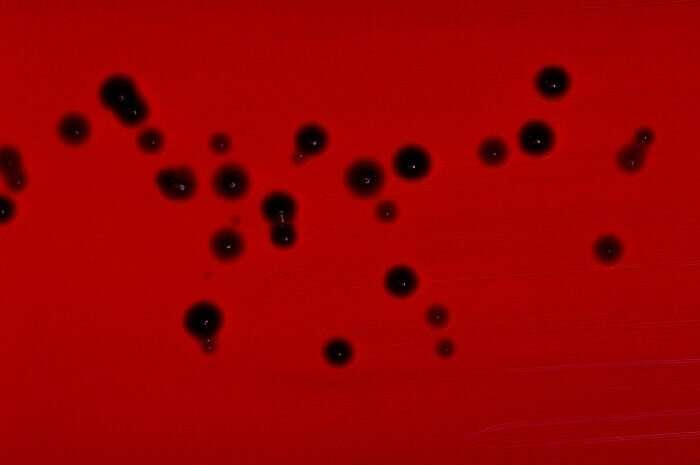Bactericidal action of violacein revealed

In an article published in the journal ACS Infectious Diseases, Brazilian researchers describe the bactericidal action mechanism of violacein, a violet pigment produced by environmental bacteria, especially Chromobacterium violaceum.
According to the authors of the study, the substance targets the cytoplasmic membrane of bacteria, mainly affecting gram-positive bacteria such as those of the genera Streptococcus, Enterococcus and Listeria. Its various biological activities include the capacity to kill even bacteria that have become resistant to antibiotics.
The investigation was conducted with support from São Paulo Research Foundation—FAPESP by the research groups led by Frederico Gueiros-Filho at the University of São Paulo's Chemistry Institute (IQ-USP) and Marcelo Brocchi at the University of Campinas's Biology Institute (IB-UNICAMP).
"This pigment's powerful bactericidal properties were discovered in 1945, yet its action mechanism has never been studied before. Many biologically active molecules are described in the literature, but if we want to use them to develop drugs, we have to know how they work," Gueiros-Filho said.
Attractive target
Violacein is a natural pigment derived from the amino acid tryptophan. It is produced as a secondary metabolite by several phylogenetically distinct bacteria found in environments as diverse as oceans, glaciers, rivers and soil. C. violaceum is the first bacterium described as a violacein producer and the most studied to date.
Violacein has attracted attention because of its wide biological activity spectrum. In addition to its potent activity against bacteria, including drug-resistant pathogens such as methicillin-resistant Staphylococcus aureus (MRSA), it has antifungal, antiprotozoal, antiviral, antitumor and antioxidant properties. Several studies describe these properties, but according to Gueiros-Filho, violacein's target and mode of action had never before been precisely identified.
The first step of the study, he explained, consisted of treating bacteria of the species S. aureus and Bacillus subtilis with violacein. Using fluorescence microscopy and a set of indicator dyes, the group found that the pigment rapidly permeabilized the bacteria cells. Cell permeabilization was accompanied by the appearance of visible discontinuities (holes or rips) in the cytoplasmic membranes, while the cell walls remained intact.
The researchers also demonstrated membrane permeabilization by measuring the leakage of ATP (adenosine triphosphate, a key energy transport and storage molecule) in the treated cells.
Next, in collaboration with the group led by Iolanda M. Cuccovia, a professor at IQ-USP, they conducted in vitro experiments that showed violacein also disrupting the structure and permeability of liposomes, spherical vesicles with an aqueous core and a membrane created in the test tube from phospholipids, the main components of organic cell membranes.
"With these experiments, we showed that the phenomenon observed in cells could be attributed to a direct effect of violacein on the membrane," Gueiros-Filho said.
In addition, computer simulations of molecular dynamics were used to explore how violacein interacts with lipid bilayers, such as those that form the cytoplasmic membrane.
Based on the results obtained, the authors of the study propose that the presence of violacein between the layers of phospholipids was sufficient to interfere with membrane organization, increasing the distance between phospholipid molecules and leading to loss of membrane integrity.
By damaging membranes, violacein is capable of destroying persistent bacteria that lie dormant as a strategy for resisting antibiotics that depend on the microorganism's metabolic activity. These bacteria form biofilms to survive in hostile environments.
The cytoplasmic membrane is an attractive and underexploited target for antimicrobials, according to the researchers, for whom the discovery that violacein is a membrane-targeting compound should set the stage for future research on the usefulness of this natural product.
The research was supported by FAPESP via the projects "How do bacteria coordinate membrane biogenesis with cell growth and division?", "Antibacterial activity of violacein against Staphylococcus aureus and pharmacokinetic studies" and "Interface chemistry: drugs, peptides and enzymes interactions with membrane models".
A key focus for future investigation is the question of violacein's selectivity. The cytoplasmic membrane is similar in and common to all living cells, so violacein may also be capable of disrupting eukaryotic cells such as those of humans. This property could be why it displays activity against so many types of pathogens, including fungi and protozoans as well as tumors, Gueiros-Filho said.
Preliminary results obtained by researchers at IQ-USP and IB-UNICAMP suggest that violacein is not highly selective for bacterial membranes and could become toxic to the host. If so, the molecule would have to be chemically modified to make it more specific.
The spread of multidrug-resistant bacteria due to the overuse of antibiotics in human medicine and agriculture is one of the most important current threats to public health. The World Health Organization (WHO) has warned of the imminence of a postantibiotic era in which common infections and minor injuries treatable for decades become lethal once again.
Most currently used antibiotics were discovered several decades ago and are directed against a limited set of targets, so the development of new antimicrobials with novel mechanisms of action is urgently needed.
More information: Ana C. G. Cauz et al, Violacein Targets the Cytoplasmic Membrane of Bacteria, ACS Infectious Diseases (2019). DOI: 10.1021/acsinfecdis.8b00245
Provided by FAPESP



















